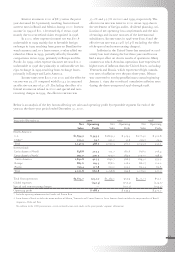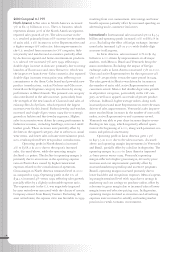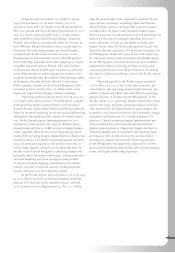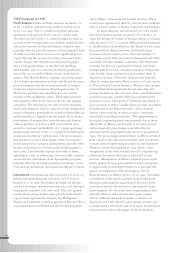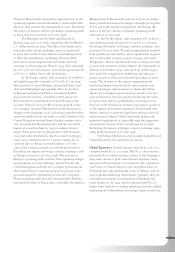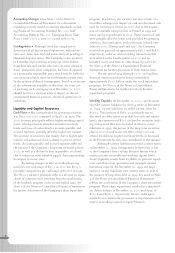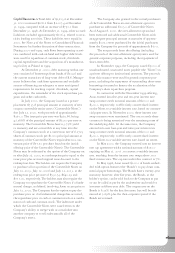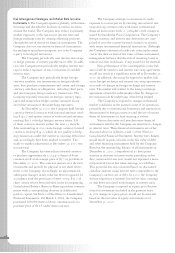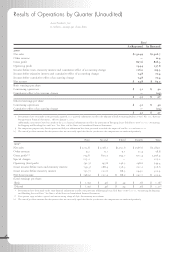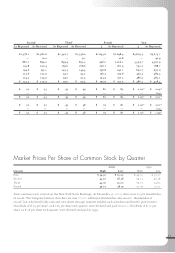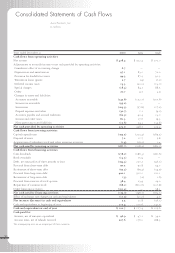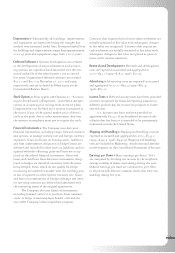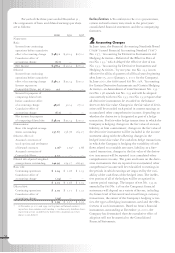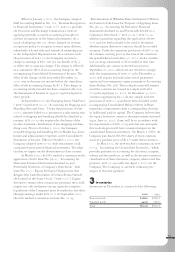Avon 2000 Annual Report Download - page 15
Download and view the complete annual report
Please find page 15 of the 2000 Avon annual report below. You can navigate through the pages in the report by either clicking on the pages listed below, or by using the keyword search tool below to find specific information within the annual report.
The Company also engages in various hedging
activities in order to reduce potential losses due to for-
eign currency risks. Consistent with the nature of the
economic hedge of such foreign exchange contracts, any
unrealized gain or loss would be offset by corresponding
decreases or increases, respectively, of the underlying
instrument or transaction being hedged. These financial
instruments are discussed above and in Note 7of the
Notes to Consolidated Financial Statements. Based on the
Company’s foreign exchange contracts at December 31,
2000, the impact of a 10% appreciation or 10% depre-
ciation of the u.s. dollar against the Company’s foreign
exchange contracts would not represent a material
potential loss in fair value, earnings or cash flows. This
potential loss does not consider the underlying foreign
currency transaction or translation exposures of the
Company. The hypothetical impact was calculated on the
combined option and forward positions using forward
rates at December 31, 2000 adjusted for an assumed
10% appreciation or 10% depreciation of the u.s. dollar
against the foreign contracts. The impact of payoffs on
option contracts is not significant to this calculation.
In 2000, net foreign exchange losses associated with the
Company’s foreign exchange contracts did not represent
a material loss in fair value, earnings or cash flows.
As of December 31, 2000, the primary currencies
for which the Company has net underlying foreign cur-
rency exchange rate exposure are the u.s. dollar versus
the Mexican peso, Brazilian real, Argentine peso, British
pound, Philippine peso, Polish zloty, Japanese yen and
the euro. The Company is also exposed to other South
American and Asian currencies.
The Company does not hedge its foreign cur-
rency exposure in a manner that would entirely eliminate
the effect of changes in foreign exchange rates on the
Company’s consolidated financial position, results of
operations and cash flows. The impact of a 10% appreci-
ation or 10% depreciation of the u.s. dollar against the
Company’s net underlying foreign currency transaction
and translation exposures could be material.
Other Information
In October 1997, the Company announced its bpr pro-
gram to streamline operations and improve profitability
through margin improvement and expense reductions.
The special and non-recurring charges associated with
this program totaled $151.2 pretax ($121.9 net of tax, or
$.47 per share on a basic and diluted basis) for the year
ended December 31, 1999 and $154.4 pretax ($122.8 net
of tax, or $.46 per share on a basic and diluted basis) for
the year ended December 31, 1998.
In connection with these programs, bpr initiatives
reduced costs by approximately $400.0 in 2000 versus
1997 levels, with a portion of the savings being reinvested
primarily in consumer-focused initiatives.
Euro
A single currency called the euro was introduced in
Europe on January 1, 1999. Eleven of the fifteen member
countries of the European Union adopted the euro as their
common legal currency on that date. Fixed conversion
rates between these participating countries’ existing cur-
rencies (the “legacy currencies”) and the euro were estab-
lished as of that date. The legacy currencies are scheduled
to remain legal tender as denominations of the euro until
June 30, 2002 after which they will be withdrawn from
circulation. During this transition period, parties may
settle transactions using either the euro or a participating
country’s legal currency. Beginning in January 2002, new
euro-denominated bills and coins will be issued.
Avon operating subsidiaries affected by the euro
conversion have established plans to address issues raised
by the euro currency conversion. These issues include,
among others, the need to adapt information technology
systems, business processes and equipment to accommo-
date euro-denominated transactions, the impact of one
common currency on pricing and recalculating currency
risk. Avon does not expect system and equipment con-
version costs to be material. Due to the numerous uncer-
tainties associated with the market impact of the euro
conversion, the Company cannot reasonably estimate the
effects one common currency will have on pricing and the
resulting impact, if any, on results of operations, financial
position or cash flows.
45


